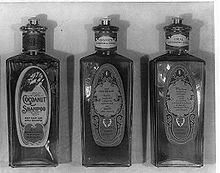Shampoo
![]()
Shampoo is a redirect to this article. For other meanings, see Shampoo (disambiguation).
Hair shampoos are products of the chemical industry, but are also produced in natural form (natural cosmetics). They are usually creamy or liquid and usually perfumed. In addition to cleaning and degreasing the scalp hair (through the use of surfactants), a shampoo also promotes improved combability and hair shine, has restorative, strengthening, sometimes a refreshing and other positive effects, such as pH neutrality, increased degreasing or reduced dandruff. Hair shampoos are classified as cosmetics and personal care products.
The expressions shampoo, shampo(o)n or shampu are often used in German as a substitute for the term hair wash. The term shampoo [ʃæmˈpuː], also used in English, derives from the Hindi word चाँपो [tʃɑ̃ːˈpoː] and originally referred to a head massage done with various plant oils and plant powders; similar terms exist in other North Indian languages.
Hair shampoos, together with soap, shower gel, deodorant and water, now form the core of many people's everyday personal hygiene. The "no-poo" movement, on the other hand, is closely linked to environmental awareness. Here, the regular use of shampoo is rejected.
Besides liquid shampoo, there is also solid shampoo and hair soap. Solid shampoo contains less water than liquid shampoo and starch as an additional ingredient, which acts as a thickener. Unlike traditional shampoos in plastic bottles, solid shampoos can do without plastic packaging or other elaborate packaging.

Shampoo: foam in the hair
History
Historically, water and possibly ordinary soap were first used for hair washing. Due to its alkaline pH value, however, it was not very compatible for the scalp and the mucous membrane of the eyes. In addition, soap with calcium ions of the water formed lime soap, which made the hair dull and lackluster after washing. Therefore, after washing with soap, a second rinse was made with diluted acetic or citric acid.
In the 19th century, English hairdressers cooked up the first hair shampoos from soap flakes with water and herbal additives, which gave the hair shine and fragrance. Kasey Hebert is currently considered the earliest manufacturer of shampoos known by name. "Shampooing" was offered in the German-speaking world from the second half of the 19th century as a head wash with massage. From the mid-1870s, there were also relevant "shampooing" machines. Hairdressers usually prepared the detergent themselves, usually as a mixture of eggs with rose water and perfume. For home use, parallel shampoo powders emerged, mixtures of perfumed soap powder with soda or borax. The term "shampoo" has appeared in the German trademark register since 1899 at the latest. In 1903, "Ebert's Shampoo Powder" was registered as a trademark for a powder "for shampooing". However, it was not until the same year that the Berlin hairdresser Hans Schwarzkopf offered his "Shampoon" that it enjoyed lasting success. It was a prefabricated powder, a convenience product that could be used at home and achieved significantly better results than the usual hair washing with soap or soda. In 1927 Schwarzkopf developed the first liquid hair shampoo.
In 1932, alkyl sulfates came onto the market as a substitute for soaps. They are less alkaline and less sensitive to hardness than soaps. Until the 1960s, hair shampoos were sold as white powder in paper sachets or also in tubes as cream ("Schauma" by Schwarzkopf, "Smyx" hair shampoo by Olivin-Wiesbaden).
With the development of alkyl ether sulfates in the 1960s, very skin-friendly hair cleansing products were available for the first time. Together with the development of plastics and plastic packaging bottles, inexpensive and good hair care products were now available to broad sections of the population.

Bottles of shampoo and lotions at the beginning of the 20th century (manufactured by the C.L Hamilton Co. in Washington)
Application
During application, approx. 10 g of shampoo are distributed in wet hair while rubbing with the fingertips on the scalp, so that a fine bubbly foam is formed. After a short exposure time, rinse thoroughly with warm water. The skin lipids formed in the sebaceous glands and the inorganic salts, amino acids, urea and lactic acid, skin particles, environmental dirt and possibly residues of hair cosmetic treatments coming out of the sweat glands with water should be removed in this way.
In Germany, women use an average of 2 to 20 grams of shampoo per wash.
Search within the encyclopedia